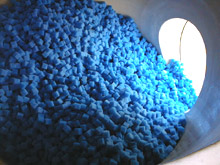This special field revolves around processes for modifying material properties (milling, cooling), composition (filtration, distillation) and type (oxidation, hydration).
Valuable information is available on a broad range of technologies including material separation, laser processes, measuring techniques and robot engineering in addition to testing methods and coating and materials analysis processes.

New data from the National Institute of Standards and Technology (NIST) will assist in the design of optics for liquid immersion lithography, an old idea that recently has attracted new interest as a possible means of improving image resolution and thereby shrinking feature sizes of computer chips.
Conventional optical lithography has advanced sufficiently to achieve a resolution of 100 nanometers (billionths of a meter), but there are physical and technical limits to how much better it can

A revolutionary breakthrough in heat transfer technology that could improve process productivity and reduce energy consumption and waste, is being developed by Ashe Morris Ltd thanks to a £100,000 investment from NESTA (the National Endowment for Science, Technology & the Arts), the largest source of early stage funding in the UK.
Heat exchangers are used in many industrial, commercial and domestic applications and can be used to add or remove heat during chemical and biological manu

A new method for treating the smell of rotten eggs emitted by sewage plants, developed in conjunction by a researcher at the Universitat Autònoma de Barcelona’s Engineering School (ETSE) and a researcher from the University of California, could lead to worldwide savings of two million euros a year. The researchers have discovered a simple method for transforming the chemical odour filters currently installed in treatment plants into equally efficient, but cheaper and less toxic, biological filters.

What would you use to try and find an underground water leak, your ears or radar? Believe it or not the only way to find water leaks involves trying to hear the hiss of the leak through a device like a stethoscope. This antiquated system could soon be a thing of the past as a fast and full-proof method using radar is being developed thanks to an investment of £76,810 from NESTA (the National Endowment for Science, Technology & the Arts), the organisation that invests in UK creativity and innovation.

In this year’s competition of the international scientific association, EUNITE, three teams have succeeded in predicting the temporal development of the five response signals in the process control of a glass melting tank (with 29 input parameters) over a period of two weeks. The – weighted – deviation of the modelled values from the real values was 0.3 per cent. The winners will present their results at the EUNITE Conference from 10th to 12th July in Oulu, Finland. As an expression of its gratitude,

A new approach that makes paper from straw, which cuts production costs and is kinder to the planet, is one step closer to reality thanks to an investment award of £90,500 from NESTA (the National Endowment for Science, Technology and the Arts) – the organisation that nurtures UK creativity and innovation.
The innovation is the brainchild of a Surrey-based environmental company, BioRegional MiniMills Ltd. The driving force behind this company is a former nurse, Sue Riddlestone who became ver